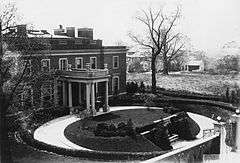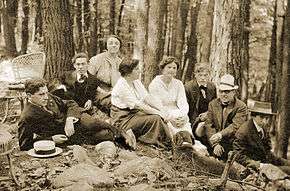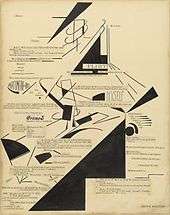Agnes E. Meyer
| Agnes E. Meyer | |
|---|---|
|
Agnes E. Meyer, 1912 | |
| Born |
Agnes Elizabeth Ernst January 2, 1887 New York City |
| Died |
September 2, 1970 (aged 83) Westchester County, New York |
| Nationality | American |
| Education | Morris High School |
| Alma mater | Barnard College |
| Occupation | Journalist, civil rights activist |
| Spouse(s) | Eugene Meyer |
| Children | 5, including Florence Meyer and Katharine Graham |
| Parent(s) | Frederic and Lucy Ernst |
Agnes Elizabeth Ernst Meyer (January 2, 1887 – September 2, 1970) was a journalist, a philanthropist, a civil rights activist, and an art patron.[1][2] From her college years to late in life, Meyer was engaged with intellectuals, artists, and writers from around the world. Meyer's marriage to American financier Eugene Meyer provided her with wealth and status that enabled her to influence national policy. Meyer used her wealth and influence to advocate for social welfare policy. She advocated for the end of racial discrimination in employment and education. Meyer's investigative journalism showed the inequities of racial segregation in schools in the metropolitan Washington, D.C. area.[2]
Meyer lobbied for the creation of the Department of Health, Education and Welfare and for the United States government to provide federal aid to states for education.[3] President Lyndon Johnson credited Meyer for building public support for the Elementary and Secondary Education Act of 1965, which for the first time directed federal assistance towards school districts that served children from low-income families.[2]
The purchase of The Washington Post in 1933 gave Meyer and her family the capacity to affect American opinion for several generations. Daughter Katharine Graham led the newspaper during the coverage of Watergate Investigation that eventually led to the resignation of President Richard Nixon and earned the paper a Pulitzer Prize.[4] During Senator Joseph McCarthy's anti-Communist campaign in the 1950s, Meyer delivered speeches that characterized the campaign as a threat to academic freedom.[5][6]
Meyer was an active patron and supporter of the arts.[7] who with her husband contributed paintings by Paul Cézanne and Edouard Manet, sculptures by Constantin Brancusi, and watercolors by John Marin.to the United States National Gallery of Art.[8]
Family life
Early life and education
Agnes Elizabeth Ernst was born on January 2, 1887, in New York City to Frederic and Lucy Ernst who were first-generation German Lutheran immigrants.[1][5] She grew up in the Pelham Heights neighborhood in The Bronx attending Morris High School.[5] As an adolescent, she clashed with her father about her ambitions. Ernst attended Barnard College over the objections of her father with her schooling paid for with a scholarship and through part time jobs. To support herself she worked as a freelance journalist at The New York Sun[1][9]
Ernst met her future husband Eugene Meyer, who was 11 years her senior, in an art gallery while she was a student at Barnard College.[3] Ernst graduated from Barnard College in 1907.[3]

Marriage and children
Ernst continued her studies at the Sorbonne in Paris for a year. She returned to the United States in 1910 and married Eugene in a small Lutheran wedding. By the time they married, Eugene was established in his career as an investment banker and was financially well off.[1]
Meyer and Eugene had five children together.[10] Their oldest daughter Florence Meyer (1911–1962) was a photographer and married to actor Oskar Homolka.[11] Elizabeth Meyer Lorentz (1913–2001) was an author who was married to Pare Lorentz.[12] Eugene "Bill" Meyer III (1915–1982) was a physician and medical professor.[13] Katharine Graham (1917–2001) was the publisher of The Washington Post. Ruth Meyer (1921–2007) married William A. Epstein.[12]
Family life in Washington, D.C.

In 1917, the Meyers relocated to Washington, D.C. For the next sixteen years Eugene had a series of positions within the federal government.[3] Eugene and Agnes Meyer lived in Meridian Park section of Washington.[14] The Meyer family first leased, in 1929, and then bought, in 1934, property on Crescent Place.[15] The property, now known as the White-Meyer House, is on the National Register.[15]
Family life in Westchester County
In 1919 the Meyer built a mansion on the Seven Springs Farm in Westchester County, New York. The house had over 60 rooms, two wings for servants, 15 bedrooms, and three pools, including an indoor pool cased in white marble from Italy.[16] The estate overlooks Byram Lake, and is at the point where the towns of North Castle, New Castle and Bedford meet.[17]
Meyer was chairwoman of the Westchester County Recreation Commission for eighteen years (1923–1941).[18]
Influence
Journalist

As a young woman working as a freelance journalist for The New York Sun, Meyer met and began cultivating lifelong friendships with intellectuals. Shortly after graduating from Barnard College, Meyer was hired by the New York Sun to be one of the newspaper's first woman journalist.[1]
From 1915–1916, she created and published the literary art magazine, 291 with Alfred Stieglitz, Marius de Zayas, and Paul Haviland.[8] Its second issue featured a full-page printed version of Mental Reactions, the earliest example of visual poetry in America, in which Meyer's poem is cut into individually trimmed blocks of pasted-down text and strewn across the page[8]

In 1933, Eugene Meyer purchased the Washington Post to which Meyer frequently contributed articles. She wrote about the problems of veterans, migrant workers, students in overcrowded schools, and African Americans.[3]
After World War II, Meyer wrote Out of These Roots: The Autobiography of an American Woman.[18]
Meyer had a twenty year long friendship with Thomas Mann[19][20] During Mann's exile to the United States, his life was "not lonely or difficult" in no small part because of his friendship with Meyer.[21][22] Meyer introduced Mann into elite social circles in New York and Washington, DC, and in 1938 found a position as lecturer in the humanities for him at Princeton University.[22][23]
During Senator Joseph McCarthy's anti-Communist campaign in the 1950s, Meyer delivered speeches that characterized the campaign as a threat to academic freedom. She spoke at the convention of the American Association of School Administrators in Atlantic City, New Jersey, calling his behavior an affront to the dignity of a free people.[5] Speaking at the Barnard Forum, Meyer argued that "security is not an aim in itself," that without freedom it "reduces life to that of the prison."[24]
Meyer's investigative journalism showed the inequities of racial segregation in the Metropolitan area Washington DC schools.[2] United States President Lyndon Johnson credited Meyer for building public support for the Elementary and Secondary Education Act of 1965, which for the first time directed federal assistance towards school districts that served children from low-income families.[2]
Civil rights activist
Meyer lobbied for integration of public schools and an end to racial discrimination in employment. Meyer advocated for the creation of the Department of Health, Education and Welfare and the United States government providing federal aid to states for education. Lyndon B. Johnson credited her with having the most influence over his education policies.[3][18]
On November 17, 1956, Agnes E. Meyer addressed the National Council of Negro Women in Washington D.C.[1]
Throughout the 1960s she continued to dedicate her time to improving public education through the creation and financial support of several not-for profit organizations.[1][3]
Philanthropy
In 1944, with her husband she created the Eugene and Agnes E. Meyer Foundation to provide funding for civic activities, particularly those related to improving public education.[1]
In 1958, Meyer with her her husband co-founded the Agnes and Eugene Meyer Fund to provide support for professors of her Alma mater, Barnard College[1] and provided funding to the New School for Social Research.[3] The next year, she founded the Urban Service Corps a program to offer mentoring to school children in Washington D.C. In 1960.[1] Meyer founded the National Committee for the Support of the Public Schools and was the chairwoman until her death.[1]
Art patronage
Meyer met Charles Lang Freer, the Detroit industrialist and collector in 1913 at a Chinese painting exhibition. Over the years, together they studied and collected Chinese and other Asian art. When Freer died before the Freer Gallery of Art was completed, Meyer and her husband took over making the final decisions.[12] During the 1993 renovation to the Gallery, the Eugene and Agnes E. Meyer Auditorium was remodeled and dedicated to them.[12]
The Meyer's family contributed painting by Paul Cézanne and Edouard Manet, sculptures by Constantin Brancus, and watercolors by John Marin to the United States National Gallery of Art.[8]
Death and legacy
While living, Meyer was honored by receiving 14 honorary degrees, and awards from the Women's National Press Club, National Association for the Advancement of Colored People (NAACP), AFL-CIO, and National Conference of Christians and Jews.[18]
At the age of 83. Meyer died of cancer at Seven Springs Farm.[3][18] After Meyer's death, the Eugene and Agnes E. Meyer Foundation donated Seven Springs Estate to Yale University. Later it was incorporated as a nonprofit conference center. In 1984 the property went to Rockefeller University, which continued to use it as a conference center.[17]
The Washington Post established the Agnes Meyer Outstanding Teacher Award in 1983 to recognize exceptional teachers. More than 500 teachers in the Metropolitan Washington area have received this honor in her name.[25]
The Library of Congress holds the Agnes Elizabeth Ernst Meyer Papers which includes her diaries, correspondence with family, friends, and her career as an author and social activist, her speeches, and an unpublished manuscript for a memoir.[5][18]
See also
References
- 1 2 3 4 5 6 7 8 9 10 11 Houck, Davis W.; Dixon, David E., eds. (2014). "Agnes E. Meyer". Women and the Civil Rights Movement, 1954–1965. University Press of Mississipp. p. 41. doi:10.14325/mississippi/9781604731071.001.0001. ISBN 978-1-60473-107-1.
- 1 2 3 4 5 "Our History | Meyer Foundation". meyerfoundation.org. Retrieved 2016-11-12.
- 1 2 3 4 5 6 7 8 9 "Agnes Ernst Meyer (1887–1970)". www2.gwu.edu. Retrieved 2016-11-12.
- ↑ "Paper Route". www.nytimes.com. Retrieved 2016-11-15.
- 1 2 3 4 5 "Agnes Elizabeth Ernst Meyer Papers" (PDF). Manuscript Division, Library of Congress. United States Library of Congress. Retrieved 2016-11-13.
- ↑ "Mother and Daughter Journalists Agnes Meyer and Katharine Graham Shaped Journalism". Women of Every Complexion and Complexity. Retrieved 17 November 2016.
- ↑ "Graham Holdings-Our Company-History". www.ghco.com. Retrieved 2016-11-12.
- 1 2 3 4 "National Gallery of Art – Recent Acquisitions". 2009-01-14. Retrieved 2016-11-12.
- ↑ Heymann, C. David (2004-11-02). The Georgetown Ladies' Social Club: Power, Passion, and Politics in the Nation's Capital. Simon and Schuster. ISBN 978-0-7434-2857-6.
- ↑ "Agnes Meyer" (PDF). Freer-Sackler. Smithsonian. 2016-02-29. Retrieved 2016-11-14.
- ↑ Ullmann, Michaela. "Research Guides: Exiled German-speaking intellectuals in Southern California: Oscar and Florence Homolka". libguides.usc.edu. Retrieved 2016-11-14.
- 1 2 3 4 Conroy, Sarah Booth (1993-04-29). "MOONLIT MEMORIES AT THE FREER FETE". The Washington Post. ISSN 0190-8286. Retrieved 2016-11-14.
- ↑ Clark, Alfred E. (1982-02-26). "EUGENE MEYER, MEDICAL PROFESSOR". The New York Times. ISSN 0362-4331. Retrieved 2016-11-15.
- ↑ Hodgson, Godfrey (2001-07-18). "Katharine Graham". The Guardian. ISSN 0261-3077. Retrieved 2016-11-12.
- 1 2 "Washington, DC—White-Meyer House". www.nps.gov. Retrieved 2016-11-15.
- ↑ Carlyle, Erin. "Inside Seven Springs, The Lavish Mansion Where The Trumps Spent Summers". Forbes. Retrieved 2016-11-13.
- 1 2 Singer, Penny (1994-07-31). "The Luxury Home Market Carries On". The New York Times. ISSN 0362-4331. Retrieved 2016-11-13.
- 1 2 3 4 5 6 Sicherman, Barbara (1980-01-01). Notable American Women: The Modern Period : a Biographical Dictionary. Harvard University Press. p. 472. ISBN 978-0-674-62733-8.
- ↑ Jonas, Klaus W.; Ashliman, D. L. (1971-01-01). "Two Previously Unpublished Thomas Mann Letters to Agnes E. Meyer". Books Abroad. 45 (4): 627–636. doi:10.2307/40125694. JSTOR 40125694.
- ↑ Meyers, Jeffrey (2012-01-01). "THOMAS MANN IN AMERICA". Michigan Quarterly Review. 51 (4). ISSN 1558-7266.
- ↑ Maier, Kurt S. (1979-01-01). "A Fellowship in German Literature: Thomas Mann, Agnes Meyer, and Archibald MacLeish". The Quarterly Journal of the Library of Congress. 36 (4): 385–400. JSTOR 29781828.
- 1 2 Kurzke, Hermann (2002-01-01). Thomas Mann: Life as a Work of Art : a Biography. Princeton University Press. pp. 416, 511. ISBN 0-691-07069-5.
- ↑ (www.dw.com), Deutsche Welle. "Thomas Mann's second home in Manhattan | Culture | DW.COM | 29.08.2012". DW.COM. Retrieved 2016-11-14.
- ↑ "Columbia Daily Spectator 8 February 1954 — Columbia Spectator". spectatorarchive.library.columbia.edu. Retrieved 2016-11-14.
- ↑ "The 2015 Agnes Meyer Outstanding Teacher Awards". The Washington Post. 2015-04-09. ISSN 0190-8286. Retrieved 2016-11-12.
Bibliography
| Library resources about Agnes E. Meyer |
| By Agnes E. Meyer |
|---|
- Chinese Painting: As Reflected in the Thought and Art of Li Lung-Mein, 1070–1106 (New York, 1923).
- Out of These Roots: The Autobiography of an American Woman (Boston, 1953).
